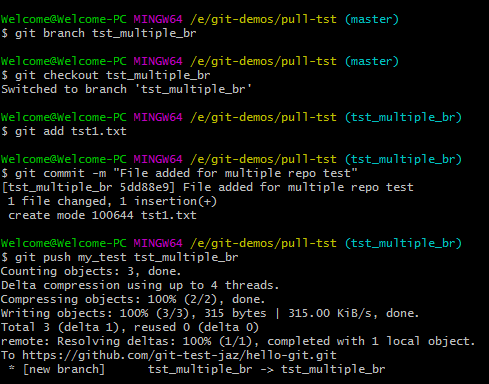

Create a new file CommitTest.txt with contents ~"test content for git tutorial"~.The steps being taken in this example are: The following example assumes you have set up a project at /path/to/project.

Now that you have a repository cloned or initialized, you can commit file version changes to it. Saving changes to the repository: git add and git commit
#GIT ADD REMOTE AND INIT FULL#
The folder will contain the full history of the remote repository and a newly created main branch.įor more documentation on git clone usage and supported Git URL formats, visit the git clone Page. The new folder will be named after the REPONAME in this case javascript-data-store. When executed, the latest version of the remote repo files on the main branch will be pulled down and added to a new folder. Git SSH URLs follow a template of: example Git SSH URL would be: where the template values match: In this example, we'll be using the Git SSH protocol. Git supports a few different network protocols and corresponding URL formats. Git clone is used to create a copy or clone of remote repositories. You'll first cd to the root project folder and then execute the git init command. This example assumes you already have an existing project folder that you would like to create a repo within. Versioning an existing project with a new git repository git subdirectory in your current working directory. Executing this command will create a new. git init is a one-time command you use during the initial setup of a new repo. To create a new repo, you'll use the git init command.

It allows you to save versions of your code, which you can access when needed. What is a Git repository?Ī Git repository is a virtual storage of your project. Configuring a Git repo for remote collaborationīy the end of this module, you should be able to create a Git repo, use common Git commands, commit a modified file, view your project’s history and configure a connection to a Git hosting service (Bitbucket).Committing a modified version of a file to the repo.git pull is a combination of git fetch and git merge.The high level points this guide will cover are: git pull: Updates your current local working branch with all new commits from the corresponding remote branch on GitHub.git push: Uploads all local branch commits to the remote.git status: Always a good idea, this command shows you what branch you're on, what files are in the working or staging directory, and any other important information.git clone : Clone (download) a repository that already exists on GitHub, including all of the files, branches, and commits.These can be linked with branches on the remote, or they could exist with no remote counterpart.

When you run git branch -all, you will also see the local working branches. This is safe to do if you are using GitHub, because branches merged via pull requests can be restored. To delete the remote tracking branches that are deleted on the remote, run git fetch -prune. But, these will stack up over time - they are not deleted automatically. These don't take up much room, so it's okay that Git does this by default.
#GIT ADD REMOTE AND INIT UPDATE#
These update every time you run git fetch or git pull. These branches are read only copies of the branches on the remote. The branches that (by default) appear in red are the remote tracking branches. If you run git branch -all in your repository, you will notice a long list of branches. Git keeps track of the branches that you work on locally, as well as each of the branches in every remote associated with your local repo. The concept of branches can be confusing once it is combined with the concept of remotes. Unless you are using one of these four commands, all of your work is only happening locally. There are four commands within Git that prompt communication with the remote. It's typical to name this remote upstream. To make it easier to pull any changes to update the local copy of the fork from the original repository, many people add the original repository as a remote also. Then, the default remote would be origin, in reference to the fork. In this case, it's common to create and clone a fork. This can be common in open source, when a contributor needs to create a fork of a repository to have permission to push changes to the remote. You may need or want to work with multiple remotes for one local repository. It's like a key value pair, and origin is the default. origin is the human-friendly name for the URL that the remote repository is stored at. You may notice origin in many messages from Git. If you try running git remote -v in your repositories, you'll probably see something called origin.


 0 kommentar(er)
0 kommentar(er)
